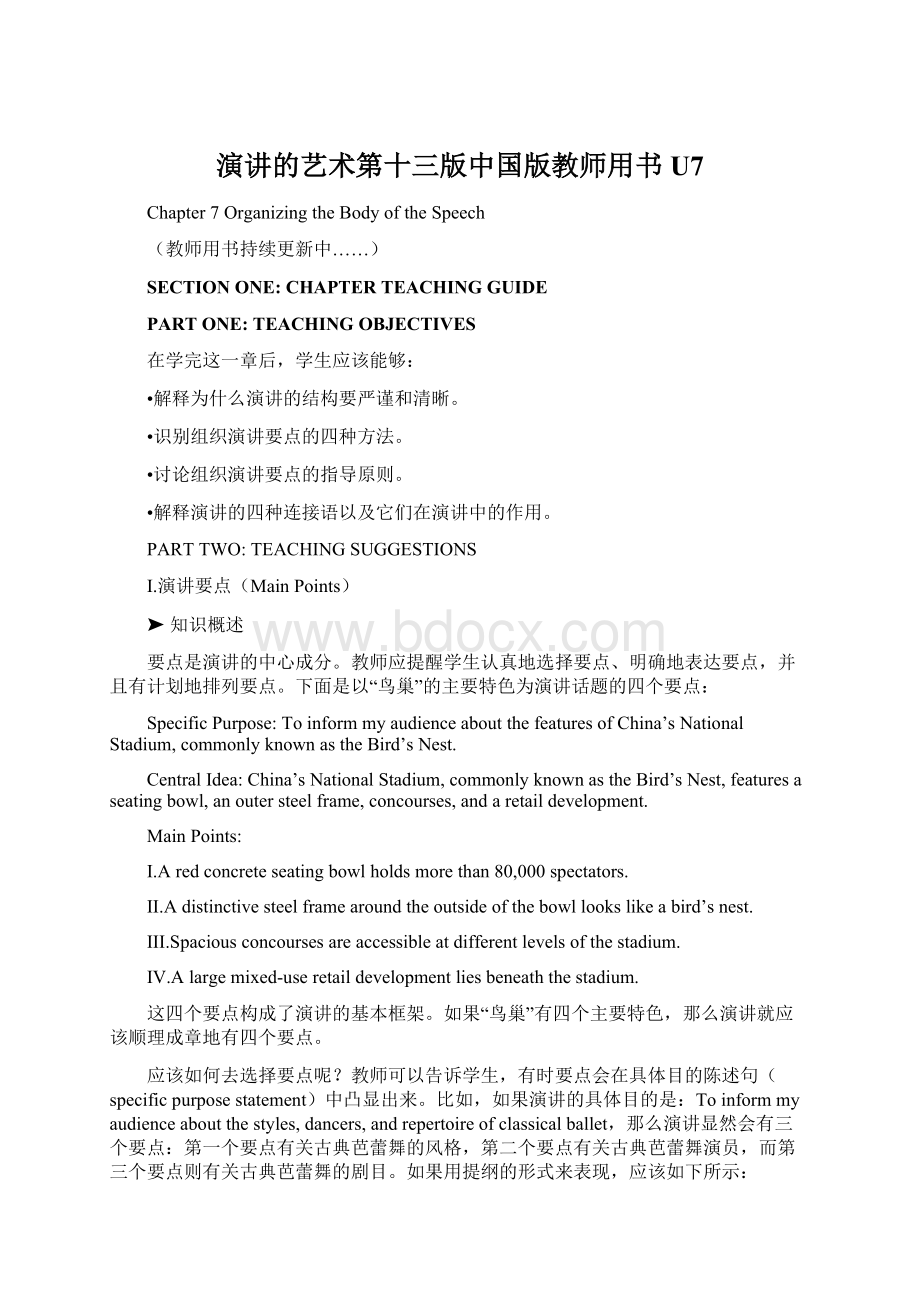演讲的艺术第十三版中国版教师用书U7Word下载.docx
《演讲的艺术第十三版中国版教师用书U7Word下载.docx》由会员分享,可在线阅读,更多相关《演讲的艺术第十三版中国版教师用书U7Word下载.docx(17页珍藏版)》请在冰豆网上搜索。

教师应提醒学生认真地选择要点、明确地表达要点,并且有计划地排列要点。
下面是以“鸟巢”的主要特色为演讲话题的四个要点:
SpecificPurpose:
ToinformmyaudienceaboutthefeaturesofChina’sNationalStadium,commonlyknownastheBird’sNest.
CentralIdea:
China’sNationalStadium,commonlyknownastheBird’sNest,featuresaseatingbowl,anoutersteelframe,concourses,andaretaildevelopment.
MainPoints:
I.Aredconcreteseatingbowlholdsmorethan80,000spectators.
II.Adistinctivesteelframearoundtheoutsideofthebowllookslikeabird’snest.
III.Spaciousconcoursesareaccessibleatdifferentlevelsofthestadium.
IV.Alargemixed-useretaildevelopmentliesbeneaththestadium.
这四个要点构成了演讲的基本框架。
如果“鸟巢”有四个主要特色,那么演讲就应该顺理成章地有四个要点。
应该如何去选择要点呢?
教师可以告诉学生,有时要点会在具体目的陈述句(specificpurposestatement)中凸显出来。
比如,如果演讲的具体目的是:
Toinformmyaudienceaboutthestyles,dancers,andrepertoireofclassicalballet,那么演讲显然会有三个要点:
第一个要点有关古典芭蕾舞的风格,第二个要点有关古典芭蕾舞演员,而第三个要点则有关古典芭蕾舞的剧目。
如果用提纲的形式来表现,应该如下所示:
Toinformmyaudienceaboutthestyles,dancers,andrepertoireofclassicalballet.
Classicalballetembracesdifferentstyles,nurturestheworld’sbestdancers,andperformsthegreatestworksintheballetrepertoire.
I.Classicalballetembracesstylesthatoriginatedindifferentcultures.
II.Classicalballetnurturesthebestdancersintheworld.
III.Classicalballetperformsthegreatestworksintheballetrepertoire.
教师可以提醒学生,尽管有时具体目的中没有明确地指出演讲的要点,但也会很容易从中找到线索。
比如,演讲的具体目的是:
ToinformmyaudienceofthefivemajorfilmandtelevisionversionsofADreamofRedMansions,那么《红楼梦》的这五种主要的电影和电视版本就会各自成为演讲的一个要点。
ToinformmyaudienceofthefivemajorfilmandtelevisionversionsofADreamofRedMansions.
TherearefivemajorfilmandtelevisionversionsofADreamofRedMansions.
I.ThefirstfilmversionwasproducedinShanghaiin1944.
II.AYuejuoperaversionwasmadeintoamoviein1962.
III.ThefirstCCTVtelevisionversionwascreatedin1987.
IV.ThesecondfilmversionwasproducedbyBeijingFilmStudioin1989.
V.ThelatestBeijingTVtelevisionversionwasreleasedin2010.
教师在讲解如何选择要点时可以和第四章内容结合,提醒学生演讲的具体目的(specificpurpose)、中心思想(centralidea)和要点(mainpoints)是密切相关的。
在写演讲稿时,只有三者都确定下来,并且互相紧密对应,才能算是构建了演讲的核心框架。
在撰写要点时可以适当增减,但最后需要确保所有要点都能涵盖中心思想。
演讲要点的组织方法(StrategicOrderofMainPoints)
教师可以告诉学生,在确定了演讲的要点后,就应该考虑决定用什么顺序来展示这些要点。
当然最佳的组织方法取决于三个要素——演讲的话题、演讲的目的和将要面对的听众。
课本的第13章和第14章将具体讨论如何组织信息性和说服性演讲的要点。
下面简单地介绍一下演讲者常用的四种基本要点组织法。
时间顺序法(ChronologicalOrder):
按时间顺序法组织的演讲采用的是时间性模式。
这种演讲往往是根据事件发生的顺序来进行叙述。
例如:
ToinformmyaudienceofthefourmajorstagesinthehistoryofTsinghuaUniversity.
TsinghuaUniversityhasgonethroughfourmajorstagesinitshistory.
I.Tsinghuawasestablishedin1911asaprepschool.
II.Tsinghuawasexpandedintoauniversityin1925.
III.TheschoolwasrenamedNationalTsinghuaUniversityin1928.
IV.Tsinghuawasgivenitscurrentnamein1949.
时间顺序法也可以用于解释一个过程或演示如何做一件事情。
Toinformmyaudienceofthebasicstepsindirectedbrainstorming.
Therearefivebasicstepsindirectedbrainstorming.
I.First,eachparticipantisgivenasheetofpaperandtoldthebrainstormingquestion.
II.Second,participantsareaskedtowriteoneresponseonthesheetandthenstop.
III.Third,participantsareaskedtoswaptheiranswersheetswithoneanother.
IV.Fourth,participantsareaskedtoimproveontheideatheyreceive.
V.Fifth,participantsareaskedtorepeatstepsthreeandfouruntilthebestideasaregenerated.
从上面的例子上可以看出,时间顺序法尤其适用于说解性演讲。
空间顺序法(SpatialOrder):
以空间顺序法为组织结构的演讲采用的是方向性模式。
也就是说,演讲的要点按照由上至下、从左到右、从前到后、从里到外、从东到西等空间顺序排列。
比如:
ToinformmyaudienceabouttheancientcentralaxisofBeijing.
TheancientcentralaxisthatrunsthroughtheheartofBeijingbeginsatYongdingmenGateinthesouth,continuesthroughTiananmenSquareandtheForbiddenCity,andendsattheBellTowerandtheDrumTowerinthenorth.
I.ThecentralaxisofBeijingbeginsatYongdingmenGateinthesouth.
II.TheaxisrunsstraightthroughTiananmenSquareandcutstheForbiddenCityinhalf.
III.TheaxisendsattheBellTowerandtheDrumTowerinthenorthofBeijing.
再例如:
ToinformmyaudienceaboutthelayoutoftheYongheLamaTemple.
TheYongheLamaTempleconsistsoffivemainhalls.
I.ThefirstmainhalloftheYongheLamaTempleistheHallofHeavenlyKings.
II.ThesecondmainhalloftheYongheLamaTempleistheHallofHarmonyandPeace.
III.ThethirdmainhalloftheYongheLamaTempleistheHallofEverlastingProtection.
IV.ThefourthmainhalloftheYongheLamaTempleistheHalloftheWheelofLaw.
V.ThefifthmainhalloftheYongheLamaTempleistheWanfuPavilion.
问题-出路法(Problem-SolutionOrder):
按照问题–出路法组织的演讲一般分为两大部分。
第一部分表明问题的存在和严重性;
第二部分提供一个解决问题的办法。
TopersuademyaudiencethatChinashouldimplementstricterlawenforcementtopreventaccidentsincoalmines.
Chinaneedsstricterlawenforcementtosolvetheproblemsofunderfund-ingandnegligencethatleadtoaccidentsincoalmines.
I.ManycoalmineaccidentsinChinaresultfromunderfundingandnegligence.
II.StricterlawenforcementwillhelppreventunderfundingandnegligenceofChina’scoalmines.
正如这个例子所表明的那样,问题–出路法一般适用于说服性演讲。
话题顺序法(TopicalOrder):
如果演讲者把演讲的话题分成几个次话题,那么每一个次话题就会成为演讲的一个要点。
比如,演讲的话题是近代民主革命家孙中山先生。
假定这个演讲的具体目的是:
ToinformmyaudienceaboutSunYat-sen’scontributionstotheChineserevolution。
针对这个具体目的,演讲者既可以采用时间顺序法,也可以采用话题顺序法。
如果使用时间顺序法,演讲者可以介绍孙中山在他生命中的每个阶段为中国革命作出的贡献;
而如果用话题顺序法,演讲者则可以将孙中山的贡献归为几大类,比如:
ToinformmyaudienceaboutSunYat-sen’scontributionstotheChineserevolution.
SunYat-seninspiredtherevolutionthatoverthrewtheQingDynasty,raisedmassivefundsfortherevolutionarycause,andchampionedtheThreePrinciplesofthePeople.
I.SunYat-seninspiredtherevolutionthatoverthrewtheQingDynasty.
II.SunYat-senraisedmassivefundsfortherevolutionarycause.
III.SunYat-senchampionedtheprinciplesofnationalism,democracy,andsocialism.
教师应提醒学生在使用话题分类法时要特别注意要点之间的逻辑性和一致性。
试想如果这个演讲的要点像下面的例子这样:
III.In1925SunYat-senmarriedSoongChing-ling,oneoftheSoongSisters,inJapan.
上面这三个要点之间缺乏必要的逻辑性和一致性。
第一个要点说明了孙中山从精神上引领了推翻清朝封建统治的革命,第二个要点陈述了孙中山为了革命事业筹集了大量的捐款,而第三个要点却将话题转到孙中山1925年在日本与宋氏三姐妹中的宋庆龄结婚,与前面的两个要点在形式上不对称,在内容上也不一致。
另外,前两个要点采用的是话题顺序法,而最后一个要点采用的是时间顺序法。
上面所举的孙中山的例子所指的是说解性演讲,话题顺序法也可以用于说服性演讲。
一般情况下,演讲的分支话题都是具体的原因,说明为什么演讲者坚持某一种观点。
下面的演讲要点主要说明为什么中央电视台应该启动一个英文版的《百家讲坛》栏目。
TopersuademyaudiencethatCCTVshouldlaunchanEnglishversionoftheLectureRoom(《百家讲坛》).
CCTVshouldlaunchanEnglishversionoftheLectureRoombecauseitwillenhanceChineseviewers’culturalawareness,encourageforeigners’participation,andenrichEnglishlearners’languageexperience.
I.AnEnglishversionoftheLectureRoomwillenhanceChineseviewers’culturalawareness.
II.AnEnglishversionoftheLectureRoomwillencourageforeigners’participation.
III.AnEnglishversionoftheLectureRoomwillenrichEnglishlearners’languageexperience.
由于话题顺序法适用于任何话题和任何一类演讲,因此比其他的演讲组织方法更为常用。
如何准备演讲要点(TipsforPreparingMainPoints)
控制要点的数量(LimittheNumberofMainPoints)。
无论演讲长度如何,如果演讲者的要点过多,听众就会感到很混乱。
在大多数情况下,一个演讲大约会包含两到五个要点。
教师可以告诉学生,如果发现要点过多,可以把它们进行归类。
下面这一套演讲要点是关于打太极拳的好处:
ToinformmyaudienceaboutthebenefitsofpracticingT’aiChi.
PracticingT’aiChihasanumberofbenefits.
I.PracticingT’aiChireducesmentalstress.
II.PracticingT’aiChiimprovesmentalconcentration.
III.PracticingT’aiChiimprovesphysicalflexibility.
IV.PracticingT’aiChiincreasescoordination.
V.PracticingT’aiChibuildsmusclestrength.
VI.PracticingT’aiChirequiresnospecialequipment.
VII.T’aiChicanbepracticedindoorsorout.
VIII.T’aiChicanbepracticedaloneorinagroup.
上面这个演讲总共有七个要点,要点过多。
如果查看一下所有列出的要点,不难看出这七个要点中所提到的打太极拳的益处可以归为三大类:
提高精力、增强体力和方便灵活。
因此,演讲者可以按下面的方式排列要点:
I.PracticingT’aiChiisgoodforthemind.
II.PracticingT’aiChiisgoodforthebody.
III.PracticingT’aiChiisconvenientandflexible.
在确定了三个要点之后,再将打太极拳的好处分类列在三个要点之下,以次要点(subpoint)的形式出现。
将要点分隔开来(KeepMainPointsSeparate)。
演讲的每一个要点都不应当混同于其他要点。
比较下面两组要点,演讲的话题是国宴的基本礼宾程式:
Ineffective
I.Statedinnersrequirespecialdresscodes.
II.
III.Statedinnersconsistofmilitaryhonorguards.
IV.Statedinnersfeatureentertainment.
V.
VI.Statedinnersincludeafour-orfive-coursemealandspeeches.
Moreeffective
VI.Statedinnersserveafour-orfive-coursemeal.
VII.Statedinnersincludespeeches.
左边列出的要点问题出在第IV点包含了两个要点,应像右边所示,将其分为两点。
要点的措辞应采用同样的模式(TrytoUsetheSamePatternofWordingforMainPoints)。
请看下面这组说解性演讲的要点:
I.ChinesecultureandlanguagearetaughtatConfuciusInstitutes.
II.ConfuciusInstituteswereestablishedtolettheworldseeChinaasanationofetiquette.
III.OnemissionofConfuciusInstitutesistocelebratetheworld’soldestcontinuouscivilization.
I.ConfuciusInstituteswer